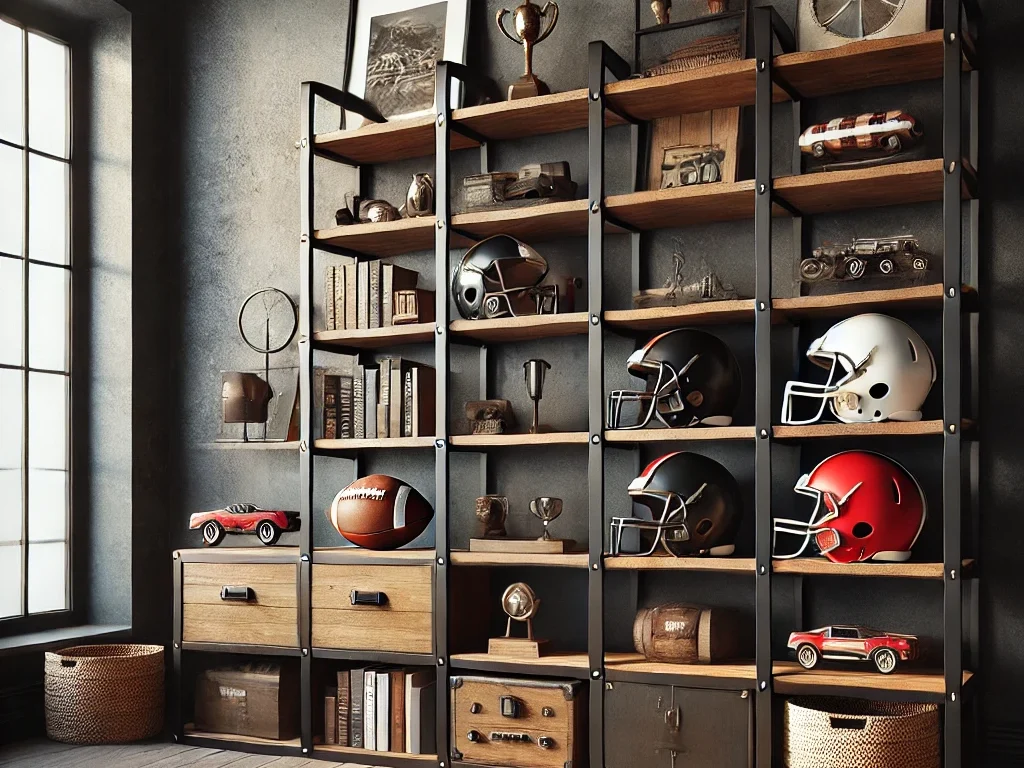Happy Friday!
Today, I’m sharing another DIY project from Peter’s Moody Masculine Mighty bedroom makeover. Last time, I showed how I transformed affordable Ikea shelving units into a custom bookcase to store his sports memorabilia and books.

For this project, I wanted to build a simple, clean-lined desk that wouldn’t take up too much visual space but still offered a spacious work surface. The result? A minimalist, floating-style desk with a rustic-industrial vibe.
To complement the mix of wood and metal from the bookcase, I opted for metal supports instead of traditional wooden legs. I wanted something subtle that wouldn’t distract from the wood top, so I chose heavy-duty shelf brackets typically used for wire shelving in closets. These brackets provide excellent support, hold significant weight, and create the illusion of a floating desk.
The contrast of warm wood tones against the dark walls adds depth and character—rustic yet refined.
How to Build a Rustic-Industrial Desk
This post includes affiliate links for your convenience. Read my full disclosure policy here.
Supplies Needed
- Plywood cut to size (I used ½-inch birch)
- Wood trim for finishing exposed edges
- Wood stain
- Stainable wood filler
- Wood glue or Liquid Nails
- Finish nails
- Heavy-duty shelf brackets
- Screws and wall anchors for mounting brackets
- Short screws for securing the wood to brackets
- Scrap wood for additional support
- Fine-grit sandpaper
Step 1: Cut the Wood
Determine the desk’s size and have a piece of plywood cut accordingly. I decided on an 18-inch depth and had a birch plywood sheet cut at the hardware store. Birch is an excellent choice for staining due to its smooth finish and attractive grain—maple is another good alternative.
For the trim, I used my compound miter saw, but a simple miter box and hand saw would work just as well!
Step 2: Stain the Wood
This is my favorite part—watching the wood transform! I applied stain using a lint-free rag (old, well-washed t-shirts work great), sanding lightly with fine-grit sandpaper between coats.
For a rich, warm finish, I mixed Minwax Jacobean with a touch of Mahogany. Since different wood species absorb stain differently, the birch desktop took on a slightly deeper tone compared to the select pine shelves of the bookcase, but the overall look remains cohesive and natural.
This rustic-industrial desk is a perfect blend of function and style, offering a sturdy workspace while maintaining an open, airy feel. Stay tuned for more DIY projects from this bedroom makeover!

Step 3: Painting and Installing the Brackets
To match the rustic-industrial aesthetic, I spray-painted the brackets with a black satin-finish spray paint—the same one used for the bookcase. (Side note: If you do a lot of spray painting, a spray can trigger grip is a game-changer—no more sore fingers!)
Once the brackets were dry, I installed them onto the wall, making sure to secure them into studs or using heavy-duty wall anchors and screws for extra stability. To provide additional reinforcement, I also added a scrap wood cleat beneath the desk. Once painted to match the wall, the cleat became virtually invisible.
With the brackets securely in place, I positioned the stained desktop on top and fastened it from underneath using screws. Be sure to use short screws to prevent them from poking through the beautifully finished wood surface!

Step 4: Attaching the Trim for a Polished Look
You can attach the trim before installing the desktop, but I waited until after since the desk sits flush against a window frame. This allowed me to customize the trim piece for a snug fit by carefully chiseling down the edge.
To secure the trim, I applied a generous amount of wood glue (or Liquid Nails) along the raw plywood edge and pressed the trim into place. Wiggling the trim slightly helps it bond better by distributing the glue evenly. Any excess glue should be wiped away immediately to prevent stains.
To keep the trim from shifting while drying, I secured it with painter’s tape and followed up with a few small finish nails. Using a nail set, I drove the nails slightly below the surface to create a smooth, seamless finish.
Step 5: Finishing Touches
Once the trim glue dried, I filled the nail holes and any gaps between the trim and plywood with stainable wood filler. After allowing it to dry completely, I lightly sanded the area with fine-grit sandpaper, taking care not to scratch the stained surface.
If any spots were still visible, I dipped a cotton swab in stain and applied a light coat for a flawless blend. As a final step, I gently rounded off the mitered corners with sandpaper to prevent sharp edges—because no one wants a desk that can double as a weapon!
And that’s it—this rustic-industrial desk is complete and ready for serious studying (or gaming, let’s be real). The combination of rich wood tones, black metal brackets, and a floating design gives the desk a sleek, minimalist vibe while still feeling warm and inviting.
This project was surprisingly simple, making it a great beginner-friendly DIY. Even if you’ve never built furniture before, you can definitely tackle this one!
Looking for more projects from this space? Check out these related posts:
[Best_Wordpress_Gallery id=”24″ gal_title=”Rustic Industrial Room”]
Wishing you all a fantastic weekend! Happy DIY-ing!

